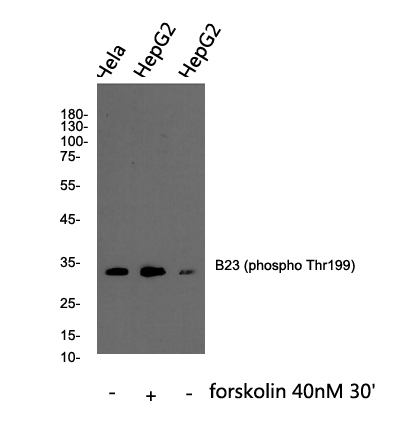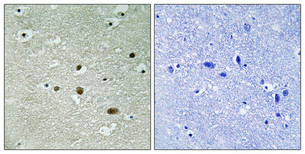
Catalog: KA1377C
Size
Price
Status
Qty.
96well
$470.00
In stock
0
Add to cart


Collected


Collect
Main Information
Reactivity
Human, Mouse, Rat
Applications
ELISA
Conjugate/Modification
Phospho
Detailed Information
Storage
2-8°C/6 months,Ship by ice bag
Modification
Phospho
Detection Method
Colorimetric
Related Products
Antigen&Target Information
Gene Name:
NPM1 NPM
show all
Other Name:
NPM1 ;
NPM ;
Nucleophosmin ;
NPM ;
Nucleolar phosphoprotein B23 ;
Nucleolar protein NO38 ;
Numatrin
NPM ;
Nucleophosmin ;
NPM ;
Nucleolar phosphoprotein B23 ;
Nucleolar protein NO38 ;
Numatrin
show all
Database Link:
Background:
disease:A chromosomal aberration involving NPM1 is a cause of myelodysplastic syndrome (MDS). Translocation t(3;5)(q25.1;q34) with MLF1.,disease:A chromosomal aberration involving NPM1 is found in a form of acute promyelocytic leukemia. Translocation t(5;17)(q32;q11) with RARA.,disease:A chromosomal aberration involving NPM1 is found in a form of non-Hodgkin lymphoma. Translocation t(2;5)(p23;q35) with ALK. The resulting chimeric NPM1-ALK protein homodimerize and the kinase becomes constitutively activated.,disease:Defects in NPM1 are associated with acute myelogenous leukemia (AML). Mutations in exon 12 affecting the C-terminus of the protein are associated with an aberrant cytoplasmic location.,function:Involved in diverse cellular processes such as ribosome biogenesis, centrosome duplication, protein chaperoning, histone assembly, cell proliferation, and regulation of tumor suppressors TP53/p53 and ARF. Binds ribosome presumably to drive ribosome nuclear export. Associated with nucleolar ribonucleoprotein structures and bind single-stranded nucleic acids. Acts as a chaperonin for the core histones H3, H2B and H4.,PTM:Acetylated at C-terminal lysine residues, thereby increasing affinity to histones.,PTM:ADP-ribosylated.,PTM:Phosphorylated at Ser-4 by PLK1. Phosphorylated by CDK2 at Ser-125 and Thr-199. Phosphorylation at Thr-199 may trigger initiation of centrosome duplication. Phosphorylated by CDC2 at Thr-199, Thr-219, Thr-234 and Thr-237 during cell mitosis. When these four sites are phosphorated, RNA-binding activity seem to be abolished. May be phosphoryled at Ser-70 by NEK2.,PTM:Sumoylated by ARF.,similarity:Belongs to the nucleoplasmin family.,subcellular location:Generally nucleolar, but is translocated to the nucleoplasm in case of serum starvation or treatment with anticancer drugs. Has been found in the cytoplasm in patients with primary acute myelogenous leukemia (AML), but not with secondary AML. Can shuttle between cytoplasm and nucleus.,subunit:Decamer formed by two pentameric rings associated in a head-to-head fashion. Disulfide-linked dimers under certain conditions. The SWAP complex consists of NPM1, NCL, PARP1 and SWAP70 (By similarity). Interacts with NSUN2. Interacts with hepatitis delta virus S-HDAg.,
show all
Function:
ribosome export from nucleus, ribosomal large subunit export from nucleus, ribosomal small subunit export from nucleus, microtubule cytoskeleton organization, DNA packaging, chromatin organization, chromatin assembly or disassembly, nucleosome assembly, RNA localization, RNA export from nucleus, rRNA export from nucleus, protein complex assembly, cell volume homeostasis, intracellular protein transport, nucleocytoplasmic transport, anti-apoptosis, cytoskeleton organization, microtubule-based process, cell cycle, centrosome cycle, aging, cell aging,protein localization, positive regulation of cell proliferation, negative regulation of cell proliferation, regulation of cell size, positive regulation of biosynthetic process, regulation of cell cycle process, negative regulation of macromolecule metabolic process, positive regulation of organelle organization, negative regulation of organelle organization,regulation of centrosome duplication, positive regulation of centrosome duplication, negative regulation of centrosome duplication, regulation of cell death, protein transport, nucleobase, nucleoside, nucleotide and nucleic acid transport,cell growth, regulation of phosphate metabolic process, cellular homeostasis, cell cycle process, ribonucleoprotein complex biogenesis, ribonucleoprotein complex assembly, microtubule organizing center organization, positive regulation of cellular biosynthetic process, chromatin assembly, regulation of cellular component size, regulation of microtubule-based process, regulation of organelle organization, negative regulation of RNA splicing, positive regulation of kinase activity, ribosome localization, establishment of ribosome localization, cellular protein localization,cellular macromolecular complex subunit organization, cellular macromolecular complex assembly, nucleosome organization, growth, regulation of cell proliferation, ribosome biogenesis, ribosome assembly, ribosomal large subunit biogenesis, ribosomal small subunit biogenesis, regulation of phosphorylation, homeostatic process, regulation of apoptosis, negative regulation of apoptosis, regulation of programmed cell death, negative regulation of programmed cell death, positive regulation of catalytic activity, positive regulation of DNA binding, regulation of RNA splicing,regulation of DNA damage response, signal transduction by p53 class mediator, regulation of kinase activity,macromolecular complex subunit organization, positive regulation of molecular function, establishment of protein localization, regulation of transcription, regulation of protein kinase activity, positive regulation of protein kinase activity, negative regulation of nucleobase, nucleoside, nucleotide and nucleic acid metabolic process, regulation of centrosome cycle, intracellular transport, regulation of nuclear mRNA splicing, via spliceosome, negative regulation of nuclear mRNA splicing, via spliceosome, nucleic acid transport, RNA transport, regulation of mRNA processing, negative regulation of mRNA processing, rRNA transport, regulation of transcription factor activity, positive regulation of transcription factor activity, positive regulation of NF-kappaB transcription factor activity, regulation of binding, positive regulation of binding, regulation of DNA binding, negative regulation of cellular component organization, positive regulation of cellular component organization, nuclear export, nuclear transport, negative regulation of nitrogen compound metabolic process, regulation of phosphorus metabolic process, establishment of RNA localization,regulation of RNA metabolic process, negative regulation of RNA metabolic process, protein oligomerization,chromosome organization, centrosome organization, regulation of transferase activity, positive regulation of transferase activity, regulation of cytoskeleton organization, organelle localization, establishment of organelle localization, regulation of cell cycle, negative regulation of cell death, macromolecular complex assembly, protein-DNA complex assembly, protein complex biogenesis, regulation of microtubule cytoskeleton organization, cellular macromolecule localization, regulation of cellular response to stress,
show all
Cellular Localization:
Nucleus, nucleolus . Nucleus, nucleoplasm . Cytoplasm, cytoskeleton, microtubule organizing center, centrosome . Generally nucleolar, but is translocated to the nucleoplasm in case of serum starvation or treatment with anticancer drugs. Has been found in the cytoplasm in patients with primary acute myelogenous leukemia (AML), but not with secondary AML. Can shuttle between cytoplasm and nucleus. Co- localizes with the methylated form of RPS10 in the granular component (GC) region of the nucleolus. Colocalized with nucleolin and APEX1 in nucleoli. Isoform 1 of NEK2 is required for its localization to the centrosome during mitosis.
show all
Reference Citation({{totalcount}})
Catalog: KA1377C
Size
Price
Status
Qty.
96well
$470.00
In stock
0
Add to cart


Collected


Collect
Recently Viewed Products
Clear allPRODUCTS
CUSTOMIZED
ABOUT US
Toggle night Mode
{{pinfoXq.title || ''}}
Catalog: {{pinfoXq.catalog || ''}}
Filter:
All
{{item.name}}
{{pinfo.title}}
-{{pinfo.catalog}}
Main Information
Target
{{pinfo.target}}
Reactivity
{{pinfo.react}}
Applications
{{pinfo.applicat}}
Conjugate/Modification
{{pinfo.coupling}}/{{pinfo.modific}}
MW (kDa)
{{pinfo.mwcalc}}
Host Species
{{pinfo.hostspec}}
Isotype
{{pinfo.isotype}}
Product {{index}}/{{pcount}}
Prev
Next
{{pvTitle}}
Scroll wheel zooms the picture
{{pvDescr}}


















